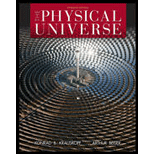
The Physical Universe
15th Edition
ISBN: 9780073513928
Author: Konrad Krauskopf, Arthur Beiser
Publisher: MCGRAW-HILL HIGHER EDUCATION
expand_more
expand_more
format_list_bulleted
Concept explainers
Question
Chapter 19, Problem 21E
To determine
The way by which the cosmic have affected the composition of the universe.
Expert Solution & Answer
Want to see the full answer?
Check out a sample textbook solution
Students have asked these similar questions
Can someone help me with this physics 2 problem thank you.
Can someone help me with this physics 2 problem thank you.
Can someone help me with this physics 2 problem thank you.
Chapter 19 Solutions
The Physical Universe
Ch. 19 - Prob. 1MCCh. 19 - Prob. 2MCCh. 19 - Prob. 3MCCh. 19 - Prob. 4MCCh. 19 - Prob. 5MCCh. 19 - Prob. 6MCCh. 19 - Prob. 7MCCh. 19 - Prob. 8MCCh. 19 - Prob. 9MCCh. 19 - Prob. 10MC
Ch. 19 - Prob. 11MCCh. 19 - Prob. 12MCCh. 19 - Prob. 13MCCh. 19 - Prob. 14MCCh. 19 - Prob. 15MCCh. 19 - Prob. 16MCCh. 19 - Prob. 17MCCh. 19 - Prob. 18MCCh. 19 - Prob. 19MCCh. 19 - Prob. 20MCCh. 19 - Prob. 21MCCh. 19 - Prob. 22MCCh. 19 - Prob. 23MCCh. 19 - Prob. 24MCCh. 19 - Prob. 25MCCh. 19 - Current ideas suggest that what is responsible for...Ch. 19 - Prob. 27MCCh. 19 - Prob. 28MCCh. 19 - The expansion of the universe apparently a. has...Ch. 19 - Prob. 30MCCh. 19 - The elements heavier than hydrogen and helium of...Ch. 19 - Prob. 32MCCh. 19 - Prob. 33MCCh. 19 - Prob. 34MCCh. 19 - Prob. 35MCCh. 19 - Prob. 36MCCh. 19 - Prob. 37MCCh. 19 - Prob. 38MCCh. 19 - Prob. 39MCCh. 19 - Prob. 40MCCh. 19 - It is likely that the planets, satellites, and...Ch. 19 - Prob. 42MCCh. 19 - Prob. 43MCCh. 19 - Prob. 1ECh. 19 - Prob. 2ECh. 19 - Prob. 3ECh. 19 - The earth undergoes four major motions through...Ch. 19 - Prob. 5ECh. 19 - Prob. 6ECh. 19 - Prob. 7ECh. 19 - Prob. 8ECh. 19 - Prob. 9ECh. 19 - Prob. 10ECh. 19 - Prob. 11ECh. 19 - Prob. 12ECh. 19 - Prob. 13ECh. 19 - Prob. 14ECh. 19 - Prob. 15ECh. 19 - Prob. 16ECh. 19 - Prob. 17ECh. 19 - Prob. 18ECh. 19 - Prob. 19ECh. 19 - Prob. 20ECh. 19 - Prob. 21ECh. 19 - There is no day-night difference in cosmic-ray...Ch. 19 - Prob. 23ECh. 19 - Prob. 24ECh. 19 - Prob. 25ECh. 19 - Prob. 26ECh. 19 - Prob. 27ECh. 19 - Prob. 28ECh. 19 - Prob. 29ECh. 19 - Prob. 30ECh. 19 - What is the observational evidence in favor of the...Ch. 19 - Prob. 32ECh. 19 - Prob. 33ECh. 19 - To what event in the history of the universe can...Ch. 19 - Prob. 35ECh. 19 - Prob. 36ECh. 19 - Prob. 37ECh. 19 - Prob. 38ECh. 19 - Prob. 39ECh. 19 - Prob. 40ECh. 19 - Prob. 41ECh. 19 - Prob. 42ECh. 19 - Prob. 43ECh. 19 - Prob. 44ECh. 19 - Prob. 45E
Knowledge Booster
Learn more about
Need a deep-dive on the concept behind this application? Look no further. Learn more about this topic, physics and related others by exploring similar questions and additional content below.Similar questions
- Explain how centripetal acceleration is affected when the hanging mass changes. Does the graph verify the relationship in equation r = x i + y j = r cosθi + r sinθj?arrow_forwardCan someone help me with this physics 2 problem thank you.arrow_forwardCan someone help me with this physics 2 problem thank you.arrow_forward
- Can someone help me with this physics 2 problem thank you.arrow_forwardTwo concrete spans of a 234 m long bridge are placed end to end so that no room is allowed for expansion (Figure a). Each span therefore has a length of L0 = 117 m. If the temperature increases by 17.8 °C, what is the height y to which the spans rise when they buckle (Figure b)? (The coefficient of linear expansion of concrete is 1.20⋅10−51.20⋅10-5 °C−1.)arrow_forwardMonkey D. Luffy, from One Piece can inflate himself like a balloon to a size of 6.98 m3 by inhaling 1.74⋅10^26 molecules of air. If the air is at 20.9 ˚C, the pressure inside Luffy is 101277.062 Pa. kB=1.38⋅10^−23 J/K. The total internal energy of the gas inside Luffy is 1065333.93 J. How fast, on average, is the air molecules inside Luffy traveling at? The average mass of an air molecule (considering the various gasses involved) is 4.51 x 10^-26 kg.arrow_forward
arrow_back_ios
SEE MORE QUESTIONS
arrow_forward_ios
Recommended textbooks for you
 An Introduction to Physical SciencePhysicsISBN:9781305079137Author:James Shipman, Jerry D. Wilson, Charles A. Higgins, Omar TorresPublisher:Cengage Learning
An Introduction to Physical SciencePhysicsISBN:9781305079137Author:James Shipman, Jerry D. Wilson, Charles A. Higgins, Omar TorresPublisher:Cengage Learning Foundations of Astronomy (MindTap Course List)PhysicsISBN:9781337399920Author:Michael A. Seeds, Dana BackmanPublisher:Cengage Learning
Foundations of Astronomy (MindTap Course List)PhysicsISBN:9781337399920Author:Michael A. Seeds, Dana BackmanPublisher:Cengage Learning Stars and Galaxies (MindTap Course List)PhysicsISBN:9781337399944Author:Michael A. SeedsPublisher:Cengage Learning
Stars and Galaxies (MindTap Course List)PhysicsISBN:9781337399944Author:Michael A. SeedsPublisher:Cengage Learning
 AstronomyPhysicsISBN:9781938168284Author:Andrew Fraknoi; David Morrison; Sidney C. WolffPublisher:OpenStax
AstronomyPhysicsISBN:9781938168284Author:Andrew Fraknoi; David Morrison; Sidney C. WolffPublisher:OpenStax Stars and GalaxiesPhysicsISBN:9781305120785Author:Michael A. Seeds, Dana BackmanPublisher:Cengage Learning
Stars and GalaxiesPhysicsISBN:9781305120785Author:Michael A. Seeds, Dana BackmanPublisher:Cengage Learning

An Introduction to Physical Science
Physics
ISBN:9781305079137
Author:James Shipman, Jerry D. Wilson, Charles A. Higgins, Omar Torres
Publisher:Cengage Learning

Foundations of Astronomy (MindTap Course List)
Physics
ISBN:9781337399920
Author:Michael A. Seeds, Dana Backman
Publisher:Cengage Learning

Stars and Galaxies (MindTap Course List)
Physics
ISBN:9781337399944
Author:Michael A. Seeds
Publisher:Cengage Learning


Astronomy
Physics
ISBN:9781938168284
Author:Andrew Fraknoi; David Morrison; Sidney C. Wolff
Publisher:OpenStax

Stars and Galaxies
Physics
ISBN:9781305120785
Author:Michael A. Seeds, Dana Backman
Publisher:Cengage Learning
General Relativity: The Curvature of Spacetime; Author: Professor Dave Explains;https://www.youtube.com/watch?v=R7V3koyL7Mc;License: Standard YouTube License, CC-BY